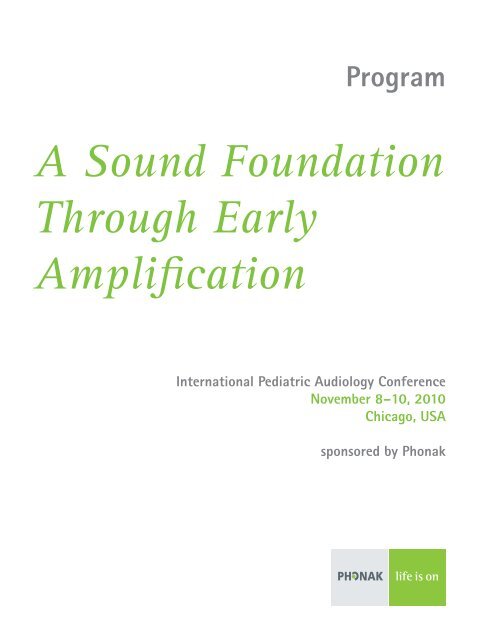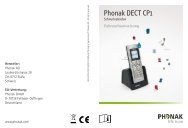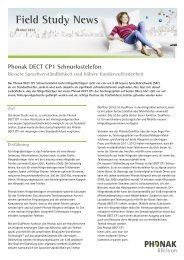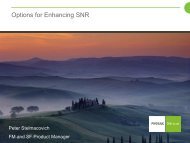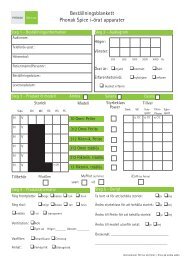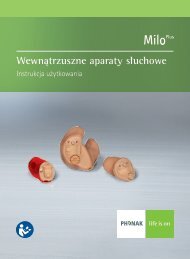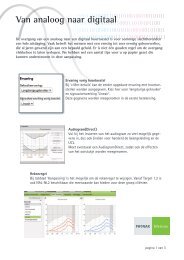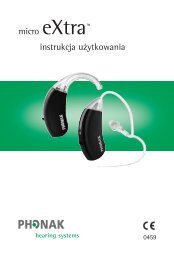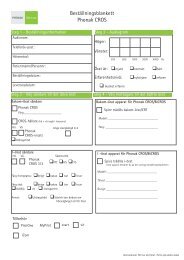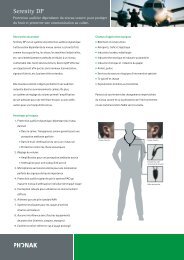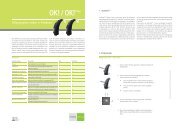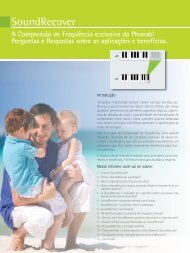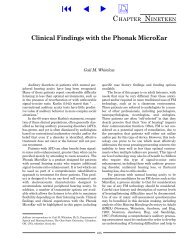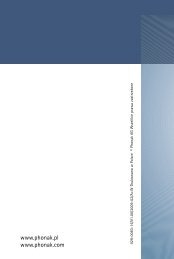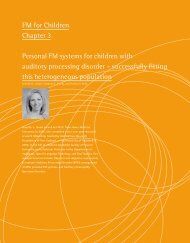A Sound Foundation Through Early Amplification - Phonak
A Sound Foundation Through Early Amplification - Phonak
A Sound Foundation Through Early Amplification - Phonak
Create successful ePaper yourself
Turn your PDF publications into a flip-book with our unique Google optimized e-Paper software.
Program<br />
A <strong>Sound</strong> <strong>Foundation</strong><br />
<strong>Through</strong> <strong>Early</strong><br />
<strong>Amplification</strong><br />
International Pediatric Audiology Conference<br />
November 8–10, 2010<br />
Chicago, USA<br />
sponsored by <strong>Phonak</strong><br />
1
Steering Committee<br />
Richard C. Seewald, Ph.D., Co-Chair,<br />
University of Western Ontario<br />
London, Ontario, Canada<br />
John M. Bamford, Ph.D., Co-Chair<br />
University of Manchester<br />
Manchester, United Kingdom<br />
Marlene Bagatto, AuD<br />
National Centre for Audiology<br />
University of Western Ontario<br />
London, Ontario, Canada<br />
Andrea Bohnert, Senior MTA-F-<br />
Pediatric Audiology<br />
Universitätsklinik für HNO und<br />
Kommunikationsstörungen<br />
Mainz, Germany<br />
Adrian Davis, Ph.D.<br />
University of Manchester<br />
Manchester, United Kingdom<br />
Janet DesGeorges, Ph.D.<br />
Hands & Voices<br />
Boulder, Colorado, USA<br />
Melody Harrison, Ph.D.<br />
University of North Carolina at Chapel Hill<br />
Chapel Hill, NC, USA<br />
Christine Jones, AuD<br />
<strong>Phonak</strong> USA<br />
Naperville, USA<br />
Stefan Launer, Ph.D.<br />
<strong>Phonak</strong> AG<br />
Stäfa, Switzerland<br />
Dawna Lewis, Omaha, USA<br />
Boys Town National Research Hospital<br />
Omaha, USA<br />
Kevin Munro, Ph.D.<br />
University of Manchester<br />
Manchester, United Kingdom<br />
Patricia Roush, AuD<br />
University of North Carolina School of Medicine<br />
North Carolina, USA<br />
Susan D. Scollie, Ph.D.<br />
The University of Western Ontario<br />
London, Ontario, Canada<br />
Patricia G. Stelmachowicz, Ph.D.<br />
Boys Town National Research Hospital<br />
Omaha, NE, USA<br />
Anne Marie Tharpe, Ph.D.<br />
Vanderbilt Bill Wilkerson Center<br />
Nashville, Tennessee, USA<br />
Dear Conference Participant,<br />
On behalf of the Conference Steering Committee and <strong>Phonak</strong>, we welcome you to A <strong>Sound</strong><br />
<strong>Foundation</strong> through <strong>Early</strong> <strong>Amplification</strong>: The Fifth International Conference.<br />
The first four <strong>Sound</strong> <strong>Foundation</strong>s Conferences, held here in Chicago in 1998, 2001, 2004, and<br />
2007 were highly successful with over 400 participants, representing more than 30 different<br />
nations, attending each. To date, more than twenty thousand copies of the Proceedings from these<br />
conferences have been distributed world-wide. This fifth <strong>Sound</strong> <strong>Foundation</strong>s conference is the<br />
result of three years of planning. We would like to take this opportunity to express our sincere<br />
appreciation to the many individuals who have participated in creating this conference on infants<br />
and children with hearing loss.<br />
First, we wish to acknowledge the many contributions of the individuals who served on the<br />
Conference Steering Committee. The quality of the conference program is a direct reflection of<br />
their extensive work over the past three years.<br />
The seemingly endless list of details associated with organizing a conference of this scope fell<br />
to Christine Jones and her group at <strong>Phonak</strong> US. Their organizational expertise and spirit of<br />
helpfulness have brought us all together for this event.<br />
Finally, we express our appreciation to the entire family at <strong>Phonak</strong> AG, and especially Ora Buerkli,<br />
for their support of this event. This conference reflects <strong>Phonak</strong>’s commitment to professional<br />
development and their longstanding dedication to quality hearing health care for children.<br />
This conference is about the services we provide to infants and children with hearing loss and their<br />
families. It is our sincere hope that you will find something at this conference that facilitates your work with infants, children<br />
and their families in the future. You are also encouraged to share your knowledge and experience with other participants during<br />
formal and informal discussion opportunities.<br />
We thank you for your participation and wish you a most enjoyable and informative experience during your stay in Chicago.<br />
A warm welcome to you all,<br />
APPROVED<br />
CONTINUING<br />
EDUCATION<br />
PROVIDER<br />
AMERICAN SPEECH-LANGUAGE-<br />
HEARING ASSOCIATION<br />
<strong>Phonak</strong>, Inc. is approved by the Continuing Education Board of the American Speech-Language-<br />
Hearing Association (ASHA) to provide continuing education activities in speech-language<br />
pathology and audiology. This program is offered for 1.1 CEUs (Advanced level; Professional<br />
area). ASHA CE Provider approval does not imply endorsement of course content, specific<br />
products, or clinical procedures.<br />
Richard Seewald<br />
Co-Chairs, Conference Steering Committee<br />
John Bamford<br />
<strong>Phonak</strong> Hearing Systems is approved by the American Academy of Audiology to offer AAA<br />
CEU’s for this activity. Academy approval of this continuing education activity does not imply<br />
endorsement of course content, specific products, or clinical procedures.<br />
2 3
Program<br />
Monday, November 8<br />
Tuesday, November 9<br />
Conference Opening<br />
8:30 Welcome and Introduction<br />
Richard Seewald (Canada) and<br />
John Bamford (United Kingdom)<br />
Identification of Hearing Loss in Infants<br />
and Children<br />
Session moderator: John Bamford<br />
8:45 Session Introduction<br />
8:50 The Judith Gravel Lecture:<br />
Infant Hearing Loss in Developing Countries -<br />
Exposing a Silent Epidemic<br />
De Wet Swanepoel (South Africa)<br />
9:30 Introduction of Keynote Address<br />
9:35 Conference Keynote Address:<br />
Universal Infant Hearing Screening: Successes and<br />
Continuing Challenges<br />
Karl White (USA)<br />
10:15 Morning Break<br />
Audiologic Diagnosis: Getting it Right<br />
from the Start<br />
Session moderator: Anne Marie Tharpe<br />
10:45 Session Introduction<br />
10:50 Buzz Off, I know what I’m Doing - The Role of<br />
Protocols in EHDI<br />
Martyn Hyde (Canada)<br />
11:25 Update on Electrophysiological Measures of Hearing<br />
Sensitivity in Infants<br />
David Stapells (Canada)<br />
12:00 Audiologic Diagnosis of Infants: Illustrative Case<br />
Examples<br />
Patricia Roush (USA)<br />
12:35 Lunch<br />
2:05 Telehealth in EHDI: Functions and Challenges<br />
William Campbell and Martyn Hyde (Canada)<br />
2:40 Session Discussion<br />
Pediatric Hearing Instrument Fitting using<br />
Modern Technologies: What, When,<br />
and Why?<br />
Session moderator: Kevin Munro<br />
3:00 Session Introduction<br />
3:05 Candidacy Considerations for Modern Implantable<br />
Hearing Technologies: An Otologist’s Perspective<br />
Craig Buchman (USA)<br />
3:40 Earmold Considerations for Optimal Spatial Hearing in<br />
Children who use Hearing Aids<br />
Patti Johnstone (USA)<br />
4:15 Directional Microphone Hearing Aid Use with School<br />
Aged Children? - Not as Simple of a Question as it<br />
Should Be<br />
Todd Ricketts (USA)<br />
4:50 Discussion<br />
5:30 –<br />
7:30 Poster Session and Reception<br />
Pediatric Hearing Instrument Fitting using<br />
Modern Technologies: What, When, and<br />
Why? (continued)<br />
8:30 Introduction and Announcements<br />
8:40 Should Digital Noise Reduction be Activated in<br />
Pediatric Hearing-Aid Fittings?<br />
Ryan Mc Creery (USA)<br />
9:15 New Developments in FM Systems for Infants and<br />
Children<br />
Leisha Eiten (USA)<br />
9:50 High-Frequency <strong>Amplification</strong>: Sharpening the Pencil<br />
Andrea Pittman (USA)<br />
10:30 Break<br />
11:00 Panel Session on Frequency-Lowering Technologies<br />
Susan Scollie (Canada) with Panel:<br />
Michael Boretzki (Switzerland)<br />
Danielle Glista (Canada)<br />
Andrea Bohnert (Germany)<br />
J ace Wolfe (USA)<br />
12:20 Discussion<br />
12:30 Lunch<br />
2:00 Pediatric Hearing Instrument Fitting in 2010:<br />
What’s New?<br />
Stefan Launer (Switzerland) and Christine Jones (USA)<br />
Measuring Outcomes from Intervention<br />
with Infants and Children<br />
Session moderator: Susan Scollie<br />
2:35 Session Introduction<br />
2:40 Beyond Matching Targets: An Approach to Outcome<br />
Evaluation in Pediatric Hearing Aid Fitting<br />
Marlene Bagatto (Canada)<br />
3:15 Understanding <strong>Early</strong> Communication Outcomes:<br />
New Tools and Insights<br />
Mary Pat Moeller (USA)<br />
3:50 Measuring Auditory Performance of Pediatric Cochlear<br />
Implant Users: What can be Learned for Children who<br />
use Hearing Instruments?<br />
Laurie Eisenberg (USA)<br />
4:25 How Speech Perception Measures can Inform<br />
<strong>Amplification</strong> Management<br />
Josephine Marriage (United Kingdom)<br />
5:00 Session Discussion<br />
6:30 An Evening with <strong>Phonak</strong><br />
Wednesday, November 10<br />
8:30 Introduction and Announcements<br />
Thinking Outside the Booth<br />
Session moderator: Melody Harrison<br />
8:40 Session Introduction<br />
8:45 The Family Consultant: Supporting Families from a<br />
Non Clinical Perspective<br />
Stephanie Olsen (USA)<br />
9:20 Working with Challenging and Under-involved<br />
Families<br />
Janet DesGeorges (USA)<br />
9:55 Parental Satisfaction, Service Quality and Outcomes<br />
Alys Young (United Kingdom)<br />
10:30 Break<br />
11:00 Child and Teen Education and Counseling<br />
Kris English (USA)<br />
11:35 Session Discussion<br />
Conference Endnote Address<br />
11:45 Introduction of Endnote Address<br />
Richard Seewald<br />
11:50 Conference Endnote Address<br />
John Bamford (United Kingdom)<br />
12:30 Conference Closing<br />
4 5
Infant Hearing Loss in Developing Countries - Exposing a Silent<br />
Epidemic<br />
De Wet Swanepoel<br />
Dept of Communication Pathology, University of Pretoria, South Africa<br />
Callier Center for Communication Disorders, University of Texas, Dallas, USA<br />
<strong>Early</strong> hearing detection and intervention programs have become the standard of care to ensure optimal outcomes for<br />
infants with hearing loss, their families and society at large. The overwhelming majority of infants with congenital or<br />
early-onset permanent bilateral hearing loss are however born in developing countries where services are scarce and<br />
awareness poor. Risk factors for congenital and early onset hearing loss are more widespread in these regions and<br />
the estimated prevalence rate is 6 in 1000 live births. A dearth of hearing health care services mean that very few<br />
infants are afforded the opportunity of early identification for hearing loss. The overwhelming burden of infectious<br />
diseases, which characterize these regions, has meant that infant hearing loss is marginalized on healthcare agendas<br />
despite its significant contribution to the global burden of diseases. Developmental, social and vocational sequalae<br />
of unidentified infant hearing loss may ultimately prohibit societal integration and participation. Novel approaches<br />
and service delivery models must be investigated to bring sustainable and contextually relevant early hearing<br />
detection and intervention services to infants with hearing loss in developing countries.<br />
Abstracts Invited<br />
Speakers<br />
Universal Infant Hearing Screening: Successes and Continuing<br />
Challenges<br />
Karl White<br />
National Center for Hearing Assessment and Management<br />
Utah State University, Logan, USA<br />
Permanent hearing loss is the most frequent birth defect in most industrialized countries and occurs even more<br />
frequently in developing countries. If not detected and treated within the first few months of occurrence, childhood<br />
hearing loss causes significant delays in cognitive, language and social development. With early identification and<br />
appropriate treatment the majority of affected children develop within normal limits. During the last 10 years a<br />
number of countries have implemented successful universal infant hearing screening programs. However, because<br />
of problems in ensuring timely and appropriate diagnosis, early intervention, and family support to infants who<br />
fail the screening test, many children with permanent hearing loss in these countries are not yet experiencing the<br />
benefits associated with early identification. Lessons learned over the past decade from successful programs and<br />
results of research studies will be used to describe the current status of infant hearing screening, diagnosis, and<br />
intervention programs, and suggestions will be given as to how various stakeholders (e.g., health care providers,<br />
public health officials, parents, and educators) can further improve existing programs.<br />
Buzz off, I know what I‘m Doing - the Role of Protocols in EHDI<br />
Martyn Hyde<br />
Mount Sinai Hospital, University of Toronto, Canada<br />
EHDI is somewhat analogous to baking a cake in someone else‘s kitchen. Part science, more than a little art,<br />
the right ingredients and the right procedures each done well in the correct sequence, in the face of an array of<br />
unpredictable factors. Protocols, whether dressed up as guidelines or as standards, are someone else‘s idea of a<br />
recipe for success. While audiologists are up to their ears in protocols from day one, there comes a point at which<br />
individual professionals‘ response to them is variable and not always favourable. This is not unusual. Despite the<br />
proliferation of evidence-based guidelines or mandatory protocols, their utilization is remarkably limited. Why, so<br />
what and if a change is necessary, how to improve the situation?<br />
This presentation is not about specific protocols, except to illustrate arguments. It is about benefits and limitations<br />
of `protocolized‘ services in the EHDI context. What is the point of a protocol? When is it helpful and when not?<br />
What makes a good one? Why is uptake variable and what are the contextual, attitudinal or behavioral causes?<br />
How should protocols be developed, disseminated, supported and adapted?<br />
6 7
In large, complex programs, there can be no systematic quality improvement without good protocols. But, they<br />
should neither threaten freedom of practice nor ignore client uniqueness. Rather, they should encapsulate key<br />
evidence and expertise, avoid reinvention of the wheel, guard against human error and liberate clinical acumen to<br />
focus upon complex aspects of practice that cannot and should not be standardized.<br />
Update on Electrophysiological Measures of Hearing Sensitivity in<br />
Infants<br />
David Stapells<br />
School of Audiology and Speech Sciences<br />
The University of British Columbia, Vancouver, Canada<br />
The auditory brainstem response (ABR) to brief tones is currently the gold-standard method to determine frequencyspecific<br />
auditory thresholds in young infants, especially those under 6 months of age. More recently, the brainstem<br />
auditory steady-state responses (ASSRs) have become of great interest in Audiology. Today’s brief talk will review<br />
and update information (& issues) concerning: (i) the need for frequency-specific threshold information (as opposed<br />
to thresholds for broadband stimuli such as clicks), (ii) the importance of bone-conduction results when hearing<br />
loss is present, (iii) current results using the brief-tone-evoked ABR, (iv) current techniques and results for the<br />
brainstem ASSRs, (v) current status of the brainstem ASSRs for audiologic use, and issues limiting their current<br />
clinical application, and finally, (vi) current tone-ABR (and to a lesser extent, ASSR) clinical protocols used by the<br />
British Columbia <strong>Early</strong> Hearing Program.<br />
Audiologic Diagnosis of Infants: Illustrative Case Examples<br />
Patricia Roush<br />
Department of Otolaryngology<br />
University of North Carolina School of Medicine, Chapel Hill, USA<br />
Over the past few decades, there has been considerable improvement in electrophysiologic procedures for<br />
assessment of auditory function in infants and young children. Even so, the behavioral assessment of hearing<br />
remains a critical and often underappreciated component of the comprehensive hearing evaluation. <strong>Through</strong> the use<br />
of case presentations, this session will illustrate the necessity of using the combination of electrophysiologic and<br />
behavioral test techniques in effective management of infants and young children with hearing loss.<br />
Telehealth in EHDI: Functions & Challenges<br />
William Campbell<br />
Thunder Bay District Health Unit, Ontario, Canada<br />
Martyn Hyde<br />
Mount Sinai Hospital, University of Toronto, Canada<br />
A major challenge in EHDI today is to optimize three key, related facets of program quality: effectiveness, equity<br />
and efficiency, for each service component and the linkages among them. This is especially difficult for programs<br />
addressing large areas, variable population densities and diverse cultures, under strong funding constraint. For<br />
families, easy access to service excellence is crucial. For providers, issues include their availability, training, skills<br />
development and decision support.<br />
Modern communications technology that is readily accessible can enhance program quality in many ways, essentially<br />
by providing rapid, distributed access to clients, clinical records and specialized expertise. This can be implemented<br />
in real time (synchronously) or after any clinical encounter (asynchronously). For example, locally accessible points<br />
of service excellence can be created efficiently by direct, remote device control, video/audio procedure monitoring<br />
and support, or by direct client interaction. Difficult cases or rare and specialized test procedures can be guided<br />
on-line or the results, interpretations and next steps reviewed off-line, creating virtual centers of tertiary service.<br />
Records, reports or follow-up plans can be shared for peer discussion, second opinion, expert input or quality<br />
management. Advanced test protocols can be downloaded and instrumentational or environmental problems can be<br />
explored and addressed remotely. Web-based pools of illustrative cases or procedures can be developed and easily<br />
accessed. Provider training and skills development can be facilitated by netmeetings and other methods of distance<br />
learning, as well as by remote observation and guidance of early clinical practice. Doubtless, these are just the tip<br />
of a telehealth iceberg in the EHDI world. Some of these facets and related challenges will be discussed in the light<br />
of existing and planned telehealth implementations in the Ontario Infant Hearing Program.<br />
Candidacy Considerations for Modern Implantable Hearing<br />
Technologies: An Otologist’s Perspective<br />
Craig Buchman<br />
Department of Otolaryngology-Head & Neck Surgery, University of North Carolina at Chapel Hill, USA<br />
A wide variety of implantable devices have become available for the management of hearing disorders. These devices<br />
can broadly be classified in to osseointegrated bone conduction devices, and middle ear, inner ear and brainstem<br />
implantable devices. While each of these devices has a relatively sound rationale for usage, the clinical experience<br />
and available safety and efficacy data are highly variable among both the adult and pediatric populations. Moreover,<br />
the usage of such devices must be framed within the context of a risk-benefit profile that compares these devices<br />
to non-invasive intervention methods. This presentation will outline the current state of knowledge for the various<br />
devices that are available and there potential usage today and in the future.<br />
Earmold Considerations for Optimal Spatial Hearing in Children who<br />
use Hearing Aids<br />
Patti Johnstone<br />
University of Tennessee Health Science Center, Knoxville, USA<br />
Measures of sound localization acuity offer a robust and reliable way to assess binaural function. Recent research<br />
has shown it to be an effective way to assess the efficacy of hearing aid technology in children with unilateral<br />
hearing loss. The current presentation will review an interactive method used to measure sound localization acuity<br />
in children and will demonstrate the clinical relevance of this method by presenting data from individual cases<br />
where changes in ear mold technology affected binaural performance.<br />
Directional Microphone Hearing Aid Use with School Aged Children?<br />
Not as Simple of a Question as it Should Be<br />
Todd Ricketts<br />
Vanderbilt University Medical Center, Nashville, USA<br />
In this session work examining directional microphone hearing aid use in school aged children will be discussed.<br />
Studies which have examined the potential for directional benefit and the directional benefit measured in several<br />
simulated classroom environments will be briefly considered. The benefits and limitations of current methods for<br />
maintaining optimal microphone mode in actual classroom environments including manual switching, asymmetric<br />
fitting and automatic switching will then be considered. These data along with case studies will be used to<br />
demonstrate the potential benefits and limitations of directional microphone hearing aids as used in a variety of<br />
every day school environments and as a basis for clinical recommendations related to selection and fitting of this<br />
technology.<br />
8 9
Should Digital Noise Reduction be Activated in Pediatric Hearing Aid<br />
Fittings?<br />
Ryan Mc Creery<br />
Boys Town National Research Hospital, Omaha, USA<br />
Digital noise reduction (DNR) is a term used to describe widely implemented signal processing strategies to help<br />
minimize the negative effects of environmental noise for individuals who use hearing aids. Studies with adults have<br />
suggested that while DNR does not typically improve nor degrade speech understanding in realistic environments,<br />
these algorithms may improve listener comfort in noise. Because some approaches to DNR may result in reduced<br />
gain for speech or degrade spectral cues, children could experience decreased speech understanding with this<br />
processing enabled. Recent studies evaluating the effects of noise reduction on children’s speech recognition, word<br />
learning and listener ratings of comfort will be discussed. Practical verification strategies that allow clinicians to<br />
estimate the potential for gain reduction with DNR will also be presented.<br />
New Developments in FM Systems for Infants and Children<br />
Leisha Eiten<br />
Boys Town National Research Hospital, Omaha, USA<br />
A number of new developments in FM transmitters and receivers have recently become available for use with<br />
children of all ages. Clinicians must balance the use of these FM features with the changing needs of children<br />
from infancy to young adulthood. This presentation will review the current FM features available and apply their<br />
different applications across the pediatric age span.<br />
High Frequency <strong>Amplification</strong>: Sharpening the Pencil<br />
Andrea Pittman<br />
Arizona State University, Tempe, USA<br />
High-frequency amplification has the potential to increase the clarity of the amplified signal for children and adults<br />
with hearing loss; however the perceptual benefits of such amplification have been difficult to demonstrate. For<br />
children, recent research has shown that high-frequency amplification significantly improves perception of some<br />
fricatives but decreases perception for others. In related studies, the lack of high-frequency amplification is thought<br />
to be responsible for delayed fricative production in young children with hearing loss during the development of<br />
speech and language. The purpose of this presentation is to relate these findings to data from word-learning studies<br />
in which the effects of bandwidth were examined in children with normal hearing and in children with hearing loss.<br />
Results indicate that children with hearing loss learn new words at a significantly slower rate than children with<br />
normal hearing and that high-frequency amplification significantly increases the rate of word-learning. Overall,<br />
the data support the use of high-frequency amplification in children with hearing loss; however longitudinal studies<br />
with a wearable device are necessary to confirm the long-term benefits to children.<br />
Pediatric Hearing Instrument Fitting in 2010: What’s New?<br />
Christine Jones<br />
Stefan Launer<br />
<strong>Phonak</strong> AG and <strong>Phonak</strong> USA<br />
Beyond Matching Targets: An Approach to Outcome Evaluation in<br />
Pediatric Hearing Aid Fitting<br />
Marlene Bagatto<br />
National Centre for Audiology, The University of Western Ontario, Canada<br />
The primary goal of <strong>Early</strong> Hearing Detection and Intervention (EHDI) programs is to provide effective intervention<br />
by six months of age to maximize the infant’s natural potential to develop language and literacy skills. Intervention<br />
with hearing aids is a common choice among families and audiologists have access to scientifically-based strategies<br />
and clinical tools to ensure the hearing aids are fitted appropriately to the infant. Outcome evaluation is a key<br />
component of the pediatric hearing aid fitting process, however, there is little research related to what a typical<br />
outcome might be for an infant who wears hearing aids and how to systematically track the child’s auditory<br />
development and performance over time. This is in part due to the lack of normed and validated outcome measures<br />
available for use with infants and children who wear hearing aids.<br />
Recently, the University of Western Ontario Pediatric Audiological Monitoring Protocol (UWO PedAMP) was<br />
developed. This outcome evaluation guideline consists of several tools that aim to measure auditory-related<br />
outcomes in infants and children who may or may not wear hearing aids and includes the following dimensions: 1)<br />
subjective assessment of early auditory development; 2) subjective ratings of auditory performance in daily life; 3)<br />
acceptance and use of hearing aids; and 4) effectiveness of service delivery. The functional outcomes are supported<br />
by each child’s hearing aid fitting information (i.e., Speech Intelligibility Index [SII]).<br />
This presentation will describe the outcome evaluation tools included in the UWO PedAMP Version 1.0 and how the<br />
guideline is administered as part of a complete pediatric hearing aid fitting protocol. The UWO PedAMP has been<br />
implemented with children of varying ages, developmental abilities and degrees of hearing loss and the impact of<br />
these variables on outcome will be presented.<br />
Understanding <strong>Early</strong> Communication Outcomes: New Tools and<br />
Insights<br />
Mary Pat Moeller<br />
Boys Town National Research Hospital, Omaha, USA<br />
The widespread implementation of early hearing detection and intervention programs has led naturally to the<br />
development of outcome measures that are appropriate for the youngest children we serve. Additional work<br />
in needed in this area. The creation of tools for characterizing developmental change is a critical step in the<br />
advancement of evidence-based practice in early intervention. Three institutions (University of Iowa, Boys Town<br />
National Research Hospital and the University of North Carolina at Chapel Hill) are collaborating on an NIDCDfunded<br />
multi-site, longitudinal investigation of the outcomes of children with mild to severe hearing loss. As<br />
part of this project, new tools have been developed to address gaps in existing measurement batteries, increase<br />
the sensitivity of evaluation strategies and/or broaden the focus of assessments. During this presentation, the<br />
following measurement strategies will be discussed: 1) an infant vocal development interview (Moeller & Bass-<br />
Ringdahl, 2009), 2) automated vocal analysis using LENA (Language Environment Analysis), 3) elicitation probes<br />
designed to assess potentially vulnerable aspects of language development in children with hearing loss, and 4)<br />
a checklist designed to assess consistency of hearing aid use. The research team has completed the first year of<br />
data collection from this 5-year project. Preliminary data from the first year of experience with these tools will be<br />
discussed. Insights regarding the utility of these tools and implications for future tool development and clinical use<br />
will be described.<br />
This presentation will describe current trends in pediatric hearing instrument fittings from the US. Current practices<br />
will be compared with historical surveys to see how fitting practices have evolved, how they correlate with current<br />
best practice guidelines and how fittings differ by age. Data used in this presentation were collected through a large<br />
<strong>Phonak</strong> market research tool that aggregates data points from more than 1000 fittings at pediatric clinics around<br />
the country and will be analyzed to look at how hearing instruments are fitted on children in the US. Specific<br />
topics to be addressed include the use prescriptive fitting formulas, application of features including sound cleaning<br />
technologies and frequency compression, the use of on board controls, and program use by age. More than 60<br />
pediatric centers from around the US contributed to this project.<br />
10 11
Measuring Auditory Performance of Pediatric Cochlear Implant<br />
Users: What can be Learned for Children who use Hearing<br />
Instruments?<br />
Laurie Eisenberg<br />
House Ear Institute, Los Angeles, California, USA<br />
Demonstration of successful outcomes with cochlear implants and hearing aids depends to a large extent on speech<br />
perception data. <strong>Through</strong>out the past 30 years of pediatric cochlear implantation, major effort has been dedicated<br />
to the development of new test measures and the formation of test batteries. Much of this effort was necessitated<br />
by the U.S. Food and Drug Administration requirements to demonstrate significant benefit of auditory implantable<br />
technology before premarket approval would be conferred. The need for new test development was particularly<br />
critical during the early years of clinical trials when the first generation devices were fairly crude and existing<br />
standard measures of speech perception yielded near floor effects. With each successive generation of cochlear<br />
implant technology, performance has been shown to steadily improve, necessitating further developments of<br />
clinically relevant speech perception measures to determine candidacy and track performance. In this presentation,<br />
the history of speech perception test development for adult and child recipients of cochlear implants will be<br />
described, followed by considerations in hierarchical assessment of children with auditory sensory devices. New<br />
directions in speech perception assessment will conclude the presentation. [Supported by NIH grants R01DC006238,<br />
R01DC004797, R01DC008875, R01DC009561]<br />
How Speech Perception Measures can Inform <strong>Amplification</strong><br />
Management<br />
Josephine Marriage<br />
Chear Ltd, United Kingdom<br />
The fitting of hearing aids based on objective hearing thresholds requires an element of trust from parents of hearing<br />
impaired infants. Auditory development requires both auditory stimulation (bottom-up), via amplification, and topdown<br />
processing to allow everyday sounds to become meaningful to the child. As the child starts to evolve speech<br />
understanding parents can begin to see the real-world benefits (or otherwise) of amplification. In clinical audiology<br />
formal speech testing has typically been done as children approach school-age, though the habilitation approach<br />
may assume that speech cues are both audible and distinct, on the basis of real ear measures. The interpretation of<br />
speech test results for fine-tuning a hearing aid prescription is often more art than science in paediatric audiology,<br />
if incorporated at all. A speech test that gives a reliable measure of phoneme detection and discrimination would<br />
allow fine-tuning of the hearing aid prescription around important speech cues, including features such as frequency<br />
compression, low frequency gain or compression characteristics. Speech testing is feasible from around 2 years of<br />
age and adds important information to the hearing management options.<br />
Results from a research study using speech testing for hearing impaired subjects aged from 2 to 8 years, are presented.<br />
Analysis of the phoneme confusions give insight into the effectiveness of different hearing aid prescriptions for<br />
differing degrees and configurations of hearing loss and the use of signal processing features to optimise speech<br />
recognition.<br />
The Family Consultant: Supporting Families from a Non Clinical<br />
Perspective<br />
Stephanie Olsen<br />
Bill Daniels Center for Children’s Hearing<br />
The Children’s Hospital of Denver, USA<br />
Helping families find their way back home after the diagnosis of a hearing loss can be difficult. This presentation<br />
will examine the specifics of family centered care and the role of The Family Consultant. This model ensures that<br />
families are fully integrated into planning and implementing their child’s care. Incorporating non clinical support<br />
can be used as a bridge between the clinical role of the audiologist and the emotional needs of the family.<br />
Working with Challenging and Under-involved Families<br />
Janet DesGeorges<br />
Hands & Voices, Colorado, USA<br />
This session will tackle the question that every Audiologist and <strong>Early</strong> Intervention Provider asks: “What do you do<br />
with the families that don’t ‘follow through’ or comply with recommendations from the professionals that serve<br />
them? Presented from the parent perspective, exploring the elements that have been proven to be instrumental<br />
in moving families up the continuum towards meaningful participation in their own child’s development will be<br />
discussed. Additionally, this presentation will define for the participant some practical tips that lead to selfawareness<br />
as practitioners to a greater understanding of the wholistic nature of the journey of raising a child who<br />
is deaf/hard of hearing.<br />
Parental Satisfaction, Service Quality and Outcomes<br />
Alys Young<br />
University of Manchester, United Kingdom<br />
Quality early intervention is at the heart of realizing better outcomes for early identified deaf children and their<br />
families. <strong>Early</strong> diagnosis is not enough. However what counts as quality, in which circumstances and for whom<br />
remains a challenge to both intervenors and families. This presentation will address the theoretical difficulties<br />
associated with defining, measuring and predicting service quality and describe the development of an parent<br />
report instrument for evaluating service quality and its properties. The instrument includes a measure of the<br />
structure of services evaluated according to timeliness and availability; the content of intervention in relation to<br />
quantity, importance and satisfaction; and the process of intervention evaluated according extent and importance.<br />
The significance of embedding an understanding of quality within parent defined priorities and family-led outcomes<br />
is also considered.<br />
Child and Teen Education and Counseling<br />
Kris English<br />
The University of Akron, Ohio, USA<br />
“Growing up well” with hearing loss is easier said than done. It involves an additional layer of self-acceptance,<br />
addressing the definition of “me as different,” and the reality that one’s hearing problem is not going away. This kind<br />
of acceptance is more achievable when children and teens have supportive adults to talk to, especially when they do<br />
most of the talking. The process of “talking out one’s problems” has been observed to have a positive effect on one’s<br />
perception of the problem and one’s ability to address it. Until those insights are obtained, new information does<br />
not get processed. This session will describe how audiologists can determine if their pediatric patients are “ready to<br />
learn” and “ready to change,” and the role of the audiologist as teacher and counselor.<br />
12 13
Abstracts Poster<br />
Session<br />
P1<br />
Author(s):<br />
Affiliation(s):<br />
P2<br />
Author(s):<br />
Affiliation(s):<br />
Usefullness of vestibular evoked myogenic potentials in<br />
newborns<br />
Lee Hui Jung, Lee Junghak<br />
Hallym University of Graduate Studies<br />
Background: More norms in newborns are needed for vestibular evoked myogenic potentials (VEMPs).<br />
Aims: The purpose of this study was to investigate normative data of VEMPs in healthy newborns. We also compared<br />
newborns under 30 days with over 30 days and investigated the differences from healthy adults.<br />
Methods: Participants consisted of 23 healthy newborns (46 ears) who passed hearing screening tests with transient<br />
evoked otoacoustic emissions and automated auditory brainstem responses and 23 healthy adults (46 ears) with<br />
normal hearing sensitivity under 20 dB HL by pure tone audiometry. VEMPs were obtained from the equipment EP25<br />
(Interacoustics).<br />
Resulats: First, the latency of p13 and n23 in newborns were 16.65 ± 2.57 ms and 26.34 ± 3.14 ms, and the<br />
amplitude of p13-n23 was 0.47 ± 0.70 µV. Second, the P13 was significantly longer in newborns under 30 days<br />
than over 30 days. Finally, the latencies and amplitude of VEMPs were significantly longer and higher in newborns<br />
than in adults.<br />
Conclusion: Normative data of healthy newborns were partially demonstrated. It is suggested that vestibular<br />
function test as well as hearing test be conducted to diagnose vestibular dysfunction at an early age, especially for<br />
newborns with high risk factors.<br />
Otitis media with effusion in the first year of life after<br />
referring on a newborn hearing screening<br />
del Valle, Tamar; Merenda, Susan<br />
Children’s Hospital Boston<br />
Background: Casselbrant & Mandel (2003) reported that greater than 50% of infants experience otitis media<br />
with effusion (OME) in their 1st year. Engle et al (1999) reported 49% peak prevalence of OME at age 10 months.<br />
Informal observation of audiometry for returning infants, age 8 to 10 months, revealed a surprising number of OME<br />
cases, sparking an interest in whether there is a correlation between newborn hearing screening (NHS) results and<br />
incidence of OME in the first year. Aim: To determine whether NHS-referred infants who also passed the follow up<br />
diagnostic ABR with normal tympanometry, are at higher risk for middle ear problems than the published incidence<br />
of middle ear problems in the general infant population. Methods: A Retrospective study was completed for infants<br />
initially evaluated by diagnostic ABR after a NHS refer and who returned for behavioral audiometry age 8 to 10<br />
months. Results: Out of 9 charts reviewed 44% had conductive hearing loss (CHL) with abnormal tympanograms,<br />
22% had normal hearing with abnormal tympanograms, and 33% had normal hearing with normal tympanograms.<br />
Conclusions: There was no greater incidence of OME in the study population than the published statistic for<br />
incidence of OME in children under 1 year old.<br />
14 15
P3<br />
Public Hearing Health Care Service in Brazil: The importance<br />
of initial processes to family engagement in the early<br />
intervention program<br />
P5<br />
Ease of listening and speech recognition for normal hearing<br />
children with digital noise reduction<br />
Author(s): Gustafson, Samantha 1 ; McCreery, Ryan 2 ; Hoover, Brenda 2 ; Kopun, Judy 2 ; Stelmachowicz, Pat 2<br />
Author(s):<br />
Figueiredo, Renata de Sousa Lima; Cavanaugh, Maria Carolina Versolatto; Novaes, Beatriz Cavalcante Albuquerque<br />
Caiuby; Mendes, Beatriz de Castro Andrade<br />
Affiliation(s):<br />
1<br />
Arizona State University; 2 Boys Town National Research Hospital<br />
Affiliation(s):<br />
Catholic University of São Paulo, PUC-SP, Brazil<br />
To describe the transition processes from diagnosis to hearing aid fitting and beginning of intervention in a population<br />
of children of low income families. It aims at discussing key factors involved teamwork when establishing auditory<br />
thresholds, verification and validation of hearing aid prescription, leading to engagement in intervention. Method:<br />
Fifteen case-evaluation of children aged between 0 and 2 years who were diagnosed at Brazil’s center for Hearing<br />
in Children. Duration of diagnostic processes, hearing aid fitting and validation integrated with the intervention will<br />
be described and discussed in relation to: auditory and early language skills. Results: This process took an average<br />
of two to four months with one session per week, depend of the presence of other handicaps, family understanding<br />
of the program, degree of hearing loss, among others. Studying these procedures within the hearing health care<br />
service becomes important do it to new regulation mandates newborn hearing screening program that, in time, will<br />
increase the demand.<br />
Digital noise reduction (DNR) algorithms aim to improve signal to noise ratio (SNR) to improve speech recognition<br />
and listener comfort in noise. This is especially important for children, who require a better SNR than adults to<br />
achieve similar levels of speech recognition. Because DNR has been found to provide no improvement or decrement<br />
in speech recognition, focus has turned to the effects of DNR on listening effort. The purpose of this study was<br />
to examine how DNR algorithms providing different amounts of SNR improvement affect speech recognition and<br />
listening effort. Twenty-four normal hearing children (ages 7-12) participated in a speech recognition task using<br />
consonant-vowel-consonant nonwords in background noise. Nonwords were recorded through two hearing aids with<br />
DNR-off and DNR-on at two SNR (0 dB and +5 dB) to produce experimental stimuli presented to listeners. Verbal<br />
response time was measured from recorded responses to examine listening effort. Results revealed a significant<br />
improvement in phoneme recognition with DNR in the device with the greater SNR improvement. A decrease in<br />
listening effort was found with DNR in both devices. Overall, results suggest that, unlike improvement in speech<br />
recognition related to DNR, reduced listening effort is not dependent upon improvement of SNR.<br />
P4<br />
The high prevalence of otitis media with effusion in children<br />
with cleft lip and palate as compared to children without<br />
clefts<br />
Author(s): Flynn Traci 1 , Möller Claes 2 , Jönsson Radi 3 , Lohmander, Anette 4<br />
P6<br />
Outcomes of children with mild-moderate hearing loss:<br />
Year one<br />
Author(s): Harrison Melody 1 , Patricia Roush 1 , Moeller Mary Pat 2 ; Tomblin Bruce 3 , Bentler Ruth 3 , Stelmachowicz Patricia 2<br />
Affiliation(s):<br />
1<br />
The University of North Carolina; 2 Boys Town National Research Hospital, 3 The University of Iowa<br />
Affiliation(s):<br />
1<br />
Institution for clinical neuroscience and physiology, Department of Audiology, Gothenburg, Sweden<br />
2<br />
The Swedish Institute for Disability Research, Örebro University Hospital, Örebro, Sweden<br />
3<br />
Sahlgrenska University Hospital, Department of Audiology, Gothenburg, Sweden<br />
4<br />
Institution for clinical science, intervention and technique, CLINTEC, Karolinska Institute, Stockholm, Sweden<br />
Objective: Children with cleft lip and palate (CLP) universally present with OME. This prevalence has not been<br />
systematically studied. The purpose of the present study was to examine and compare the prevalence of OME,<br />
hearing sensitivity, and audiometry methods utilized for assessment in children with and without clefts.<br />
Methods: Two groups of children (UCLP, N=22, and without clefts, N=20) were followed prospectively from 1 to 5<br />
years of age. Data were collected at four points including: (1) otomicroscopy, (2) tympanometry, and (3) hearing<br />
assessment.<br />
Results: The children with UCLP demonstrated a significantly higher prevalence of OME than children without<br />
clefts. Of those ears with OME, 83.1% exhibited a hearing loss, with this loss more prevalent in the cleft group.<br />
Children with UCLP utilized a lower age-appropriate audiometry testing method than children without clefts at<br />
younger ages.<br />
Conclusions: This presentation highlights the findings of children with UCLP demonstrating a significantly higher<br />
prevalence of OME than children without clefts and the hearing loss associated with OME. Finally, the method of<br />
audiometry utilized with both groups of children will be presented and discussion will include if a greater period of<br />
hearing loss in the UCLP children may lead to a slower cognitive development.<br />
In 2008, the U.S. National Institutes for Health funded a five year, multi-center grant to study the moderators of<br />
outcomes of children with mild-to-severe hearing loss. Although the majority of children in the U.S. have hearing<br />
loss in this range, the requisite clinical studies needed to describe the factors influencing outcomes for this group<br />
of children have not been conducted. Much of what we know about children with mild-to-severe hearing loss is<br />
based upon research conducted 15-20 years ago, prior to implementation of newborn hearing screening, access to<br />
early intervention, and the technological advances found in current hearing technologies.<br />
One of the largest known contributors to outcomes in children with hearing loss is reduced auditory /linguistic<br />
experience. Thus, a primary the focus of the study is to examine variations in the delivery and effectiveness of<br />
early services including hearing aid fitting and use, and early intervention services. A comprehensive set of child<br />
outcome measures (e.g., speech perception and production, language, academic, psychosocial, cognitive) and family<br />
outcome measures (parenting, satisfaction with services, and quality of life) that support early development are<br />
being collected. Selected data from the first 12 months of testing will be presented.<br />
16 17
P7<br />
My patient is taller than me! Now what? Developing a plan<br />
for teenagers to transition to adult audiology services<br />
P9<br />
The relation between the time duration usage of hearing<br />
aids of children in therapy and the therapy’s efficiency<br />
Author(s:)<br />
Affiliation(s):<br />
P8<br />
Schroeder Kristen, Rall Eileen, Montoya Louise, Reyes Jose<br />
The Children’s Hospital of Philadelphia<br />
Background: <strong>Through</strong>out the “teen” years, adolescents are faced with the dual challenges of establishing their<br />
sense of identity and starting their transition to adulthood. These challenges may be magnified when a teenager<br />
is hearing impaired.<br />
Aims: As audiologists, we can support our teenage patients as they plan and transition into adulthood. Our teen<br />
patients should understand the impact their hearing loss has on communication and how to relay that information<br />
to educators, healthcare providers, and others.<br />
Methods: Audiologists should collaborate with teens and their families to develop a comprehensive transitioning<br />
plan. This plan should be driven by patient and family needs and can be used to promote understanding of the<br />
impact of hearing loss on alerting and safety, independent use of equipment, self-advocacy when communication<br />
needs arise, problem-solving skills and using multiple forms of communication and preparedness for emergency<br />
situations. Resources available through PEPNet and the GAP learning guide will be highlighted.<br />
Conclusions: Audiologists can support our teen patients by engaging them as young adults in discussions about<br />
life in general, post-secondary education support, and transition planning for adulthood. This poster highlights<br />
strategies for developing a transitioning plan.<br />
Influence of Polish Universal Neonatal Hearing Screening<br />
Program on early cochlear implantation in Poznań, Poland<br />
Author(s):<br />
Affiliation(s):<br />
Cilmara CAC Levy; Priscila ML Capps<br />
ISCMSP- Brazil<br />
Introduction: The technological advance of hearing aids provided many benefits for individual adaptation in<br />
children. Nowadays, it is possible to have better control over the therapeutic efficiency by using the Datalogging<br />
program that stores data and reports the average hearing aids use.<br />
This study is aimed to assess the relationship between the time of hearing aid usage along with the children’s speech<br />
therapeutic process at the Brotherhood of Santa Casa de Misericórdia de São Paulo.<br />
Method: This study was conducted at the Speech Therapy Clinic of the Brotherhood of Santa Casa de Misericordia<br />
de Sao Paulo.<br />
Study participants were 9 children between the ages of 1 to 5, six females and 3 males. The evaluation criteria<br />
used was hearing aids Naida SP/UP <strong>Phonak</strong> and all the children are being seen and follow up at the clinic. The study<br />
was conducted by using analysis data from Datalogging program. The data collection was done on a weekly basis<br />
for a period of a month.<br />
Results: The results showed that not only where the parents informed about hearing aid usage but also they did<br />
not use them as we hoped they would, therefore reaching a relatively low average of daily use. Weekly orientation<br />
will make it possible for the children’s effective usage of hearing aids, allowing a closer dialogue with the parents<br />
and making the family more committed, responsible and in partnership with the Speech Therapy Clinic to use the<br />
hearing aids correctly.<br />
Conclusion: This is a great ally for the audiologist team and family of evidence for more successful hearing aids<br />
outcomes.<br />
Author(s): Sekula Alicja 1 , Karlik Michał 1 , Wiskirska-Woźnica Bożena 1 , Szyfter Witold 2 , Szyfter-Harris Joanna 1 ,<br />
Wróbel Maciej 2<br />
Affiliation(s):<br />
1<br />
Department of Phoniatrics and Audiology,<br />
2<br />
Department of Otolaryngology; Poznań University of Medical Sciences, Poznań, Poland<br />
Owing to the initiative of the Polish citizens and support of the Great Orchestra of Christmas Charity <strong>Foundation</strong> – a<br />
charitable organization, the National Universal Neonatal Hearing Screening program in Poland was introduced. The<br />
program began in the end of 2002 in all neonatal units in Poland and screened all newborn children. After 7 years<br />
of running the program (between 2003 and 2009) a total number of 2,698,491 children were screened for hearing<br />
impairment, what stands for 98.52% of all delivered babies, registered in Poland.<br />
The program enabled early audiological intervention, including hearing aids fitting as well as cochlear implantation<br />
in cases of bilateral profound hearing loss.<br />
Department of Phoniatrics and Audiology in Poznań is a center of the second and the top, third level of the<br />
programme. At the moment over 3000 children were examined. 61 children at the age below 24 months were<br />
qualified and implanted till the and of August 2010.<br />
Audiological results from three levels of the program are presented, as well as rehabilitation methods used before<br />
decision of cochlear implantation.<br />
Mean age of children implanted before and after 2003 is presented. The important decrease of the age of children<br />
diagnosed and implanted was noticed.<br />
Usefullnes of Universal Neonatal Hearing Screening Program for early audiological intervention, as wel as early<br />
cochlear implantation is emphasised.<br />
P10<br />
Author(s):<br />
Affiliation(s):<br />
<strong>Sound</strong> Field Initiative: How to win teachers and influence<br />
administrators<br />
Frankie Mickelsen<br />
Prince George’s County Public Schools, Maryland<br />
This poster will provide information and statistics on <strong>Sound</strong> Field <strong>Amplification</strong> in the general education classroom.<br />
The rationale will be given as to why sound field amplification is an important asset to a classroom; the benefits<br />
of such technology; the goals of providing this technology to kindergarten and first grade classrooms; the methods<br />
used to install and train general education teachers on its use; results of installing the technology system-wide; the<br />
sources of funding (which is the main point in school budgets); results and testimonials of teachers; and conclusions.<br />
18 19
P11<br />
Author(s):<br />
Affiliation(s):<br />
P12<br />
Bridging the research to clinical practice gap: Use of<br />
the Network of Pediatric Audiologists of Canada<br />
to facilitate the development of the UWO Pediatric<br />
Audiological Monitoring Protocol (UWO PedAMP v1.0)<br />
Sheila T.F. Moodie 1 , Marlene Bagatto 1 , Susan Scollie 1 , Richard Seewald 1 , Anita Kothari 2 , Linda Miller 3 and The<br />
Network of Pediatric Audiologists of Canada<br />
1<br />
National Centre for Audiology, Faculty of Health Sciences, University of Western Ontario, London, Canada<br />
2<br />
Faculty of Health Sciences, University of Western Ontario, London, Ontario, Canada<br />
3<br />
Faculty of Health Sciences and School of Graduate and Postdoctoral Studies, University of Western Ontario,<br />
London, Ontario, Canada<br />
In 2009, researchers in the Child <strong>Amplification</strong> Laboratory at The University of Western Ontario began development<br />
of a pediatric audiological monitoring protocol (the UWO PedAMP) to be used with children with permanent<br />
childhood hearing impairment (PCHI). One of the main objectives during the development phase of this project was<br />
to proactively address any barriers that could be foreseen to clinical implementation of the UWO PedAMP guideline.<br />
Analyses of barriers to practice change indicate that obstacles to change arise at many levels, including the level of<br />
the guideline (ex.relative advantage, trialability); the individual practitioner (ex. habit), the organization (ex. staff<br />
turn-over), and the wider practice environment (ex. support for change). In an effort to address this knowledge-toclinical<br />
action gap, we partnered with pediatric audiologists across Canada in a dynamic, interactive and iterative<br />
process to ensure that factors influencing uptake of the UWO PedAMP in practice could be identified, better<br />
understood and addressed during the initial development phase. This poster presents the results of this project.<br />
Barriers to implementation of the individual components of the UWO PedAMP v1.0 at the guideline, practitioner<br />
and organization levels were identified by the Network Clinicians and modifications where possible were made to<br />
the UWO PedAMP.<br />
This poster presents the results of this work and will describe the knowledge-to-action framework and results of the<br />
individual assessment of each of the measures included by the pediatric audiologists across Canada. In addition a<br />
description of how this collaborative and dynamic approach facilitated the development of version 1.0 of the UWO<br />
PedAMP will be provided.<br />
Development of Universal Newborn Hearing Screening<br />
Programme in Republic of Macedonia<br />
Author(s): Femikj Natasha 1 , Chakar Marina 2<br />
P13<br />
Author(s):<br />
Affiliation(s):<br />
reduce the age at which infants with hearing loss were diagnosed and treated in the Republic of Macedonia.<br />
Methods :The protocol consisted of three stages. In the first two stages newborns were tested with transient clickevoked<br />
otoacoustic emissions. The first TEOAE test was performed by 24h of age(before discharge from hospital).<br />
The second one after 30 days in case of referral (in some cases babies were screened with the second TEOAE before<br />
the discharge from the hospital).The third stage was performed by diagnostic ABR ,for those babies who failed the<br />
second TEOAE stage.<br />
Results:The whole number of screened babies is 570: 527 without risk and 43 at risk of hearing impairment.<br />
Bilateral hearing impairment was identified in 5 newborns ( 2 from the no-risk and 3 from the at-risk population).<br />
Unilateral HL was found in 2 newborns from at-risk population.<br />
Conclusions:The results show that the introduction and implementation of a hospital-based, universal neonatal<br />
hearing screening programme in the Republic of Macedonia, is feasible and effective. All these support our wish<br />
and determination to work dedicated on further development of the NHS in the country.<br />
The importance of sensitive test methods for determining<br />
benefits of high frequency audibility<br />
Myriel Nyffeler, Michael Boretzki, Nicola Schmitt, Frederik Eichhorn, Julia Rehnmann, Andrea Kegel and Katrin<br />
Meisenbacher<br />
<strong>Phonak</strong> AG, Stäfa, Switzerland<br />
The effectiveness of <strong>Phonak</strong>’s proprietary nonlinear frequency compression algorithm, <strong>Sound</strong>Recover, has been<br />
documented for a wide range of hearing losses in various independent studies. <strong>Sound</strong>Recover allows a portion of the<br />
incoming sound above a particular cut-off frequency to be compressed and shifted to lower frequencies, whereas<br />
no frequency changes are made for sounds below the cut-off frequency. However, to measure high frequency<br />
speech cues such as the consonants /s/, /z/, /sh/, /f/, /d/, /k/ and /t/, more sensitive test methods are necessary since<br />
conventional sentence and word test have the weakness that single phonemes can be discerned on the basis of word<br />
or sentence contexts. Here, the Adaptive Logatome Test and the University of Western Ontario (UWO) plural test are<br />
discussed as sensitive test methods to evaluate consonant identification and detection with <strong>Sound</strong>Recover. <strong>Phonak</strong>’s<br />
Logatome test uses an adaptive presentation level and measures the respective identification thresholds of various<br />
consonants in nonsense syllables in dB SPL, whereas the UWO plural test uses a fixed control of the presentation<br />
level and measures the detection of plural words which are represented as percentage correct. To determine the<br />
strengths and limits of evidence about the effectiveness of measuring identification and detection thresholds<br />
for high frequency speech cues/ consonants the two tests are discussed in terms of sensitivity, application, age<br />
appropriateness, language ability needed, duration of the test, test setups and the use of the data for each. Together,<br />
they offer an effective and sensitive test battery to evaluate high frequency audibility and, therefore, benefits of<br />
<strong>Sound</strong>Recover for a wide range of hearing losses.<br />
Affiliation(s):<br />
1<br />
National coordinator of NHSP of RMacedonia;<br />
2<br />
Centre for Audiology of the University ENT Clinic, Skopje, Macedonia<br />
Introduction: Despite of the difficult economic situation ,transition and efforts of the country on its road to join<br />
the Europe Union the Government and Ministry of Health of the Republic of Macedonia recognized and accepted<br />
the importance of NHSP.The initiative for introduction of the Universal newborn screening programme and for<br />
purchasing of hearing screening equipment came from Natasha Femikj,audiologist from Bitola (the Ministry of<br />
Health appointed her as a national coordinator).<br />
The equipment-screening TEOAE-OtoRead,Interacoustics- was delivered to the hospitals in 3 cities: Bitola, Tetovo<br />
and Strumica. Audiology Center of University ENT Clinic in the main city-Skopje was supplied with diagnostic<br />
ABR,Interacoustics .In the Republic of Macedonia an annual birth rate is approximately 23000 newborns.In Bitola<br />
for 2009 an annual birth rate was 1300;for Tetovo 2200 and for Strumica 1300 newborns.<br />
Aim: NHS Programme started on January 12, 2010 as Universal NHS Programme for both babies with no risk and<br />
those at risk of hearing impairment. The Government will continue with the development of the Programme and<br />
in the next phase the Ministry of Health will supply screening TEOAE for next 3 cities in the country. Our goal is to<br />
P14<br />
Author(s):<br />
Affiliation(s):<br />
Development and adaptive behavior in youngchildren with<br />
hearing loss: Study design and peliminary data<br />
Johnson, Karen 1 ; Eisenberg, Laurie 1 ; Stika, Carren 2 ; Henning, Shirley 3 ; Colson, Bethany 3 ; DABCHL Investigative<br />
Team 1,2,3<br />
1<br />
House Ear Institute; 2 San Diego State University; 3 Indiana University School of Medicine<br />
Development and Adaptive Behavior in Young Children with Hearing Loss is a prospective investigation designed<br />
to identify factors leading to successful outcomes in young children with mild to severe hearing loss. The study<br />
combines longitudinal and cross-sectional designs to determine the developmental trajectories of social-emotional<br />
and adaptive functioning in young hard of hearing children (HH) from infancy to preschool age. Children between<br />
12 and 48 months of age currently are being enrolled from two investigational sites: the House Ear Institute and<br />
20 21
P15<br />
Indiana University School of Medicine Children. Normal hearing children (NH) serve as controls.<br />
Children are assessed at annual intervals within the domains of audition, speech perception, language, cognition,<br />
social-emotional development, and adaptive functioning. Parents are assessed in terms of their involvement and<br />
self-efficacy, emotional availability, and language input. Factors related to intervention services are also being<br />
delineated. Preliminary data analysis has shown little difference between the HH and NH groups on most measures.<br />
However, a difference has been observed in the domain of social-emotional competency (i.e., compliance, empathy,<br />
prosocial peer interactions, mastery motivation, play skills, and attention), based on parent ratings. This early finding<br />
may point to the importance of tracking social-emotional development in young children with hearing loss.<br />
Emotion recognition and theory of mind in children with<br />
hearing loss<br />
Author(s): Porter, Heather 1 ; Tharpe, Anne Marie 1 ; Sladen, Douglas 2<br />
Affiliation(s):<br />
P16<br />
1<br />
Vanderbilt University; 2 University of Texas at Austin<br />
Psychosocial development tends to be influenced by speech and language ability, but other factors might also<br />
influence development of social and emotional abilities in children with hearing loss. This study examined two<br />
specific aspects of social cognition, emotion recognition and Theory of Mind (ToM), in 41 children within two age<br />
groups (i.e., 4-6 years and 10-12 years) with and without hearing loss. Younger children with hearing loss had lower<br />
emotion recognition scores than younger children with normal hearing. Children with hearing loss demonstrated an<br />
understanding of knowledge access, false-belief, and real-apparent emotion in the same sequence as children with<br />
normal hearing, but did so at later ages. Empirical review of data comparing emotion recognition scores and ToM<br />
scores showed that the relationship was not linear. The data were fit to a logistic regression model suggesting that<br />
children begin to successfully complete ToM tasks once they reach ≥67% accuracy on the emotion recognition task.<br />
These results support past findings that showed children with hearing loss tend to have lower emotion recognition<br />
and ToM scores than their peers with normal hearing. In addition, they extend past knowledge in this area by<br />
suggesting a non-linear association between emotion recognition and ToM.<br />
Evoked potential and behavioral measures of auditory<br />
processing in children with auditory processing disorders:<br />
Test-retest reliability and training effects<br />
Author(s): Suzanne C. Purdy 1 , Mridula Sharma 2 ; Andrea S. Kelly 1,3<br />
Affiliation(s):<br />
1<br />
University of Auckland; 2 Macquarie University; 3 Auckland District Health Board<br />
School aged-children with suspected auditory processing disorder were assessed on three occasions, two times<br />
before and once after a 6-week intervention. Participants aged 7 to 13 years were randomly assigned to a control<br />
group or to one of the treatment groups receiving one of two types of training (discrimination and phonological<br />
awareness training versus language therapy), with and without personal FM. Bilateral FM systems were worn during<br />
school hours for the two groups receiving training plus FM. Both training approaches resulted in positive outcomes<br />
for various language, auditory processing and phonological awareness measures, as did the use of personal FM<br />
systems. Cortical auditory evoked potentials (CAEPs) to speech in noise showed significant test-retest differences in<br />
N250 amplitudes, consistent with passive auditory training effects previously reported for adult listeners undergoing<br />
CAEP testing. Systematic changes in CAEPs were seen across the three test sessions (i.e. during the baseline period<br />
and after treatment), making it difficult to evaluate treatment effects based on the evoked potential findings. In<br />
addition to showing the benefits of interventions for APD, the results highlight some of the barriers to showing<br />
treatment effectiveness such as test-retest variability and passive training effects of testing.<br />
P17<br />
Author(s):<br />
Affiliation(s):<br />
P18<br />
Author(s):<br />
Affiliation(s):<br />
Young children’s attitudes towards their peers who wear<br />
hearing aids<br />
Rentmeester, Lindsey; Tharpe, Anne Marie<br />
Vanderbilt University Medical Center<br />
The “hearing aid effect” is a phenomenon that describes negative attitudes toward children wearing hearing aids<br />
when compared to their normal hearing peers. The hearing aid effect has been found in adult observers and child<br />
observers as young as 10 years of age. The purpose of this study was to determine whether the hearing aid effect<br />
is present in young children and if there is a difference between the attitudes of young children (aged 6-7 years)<br />
and older children (aged 9-10 years). Children with normal hearing were asked to rate photos of their peers with<br />
a hearing aid and without a hearing aid in social acceptance, and physical and cognitive competence. The findings<br />
from this study suggest that when directly compared to their peers without hearing aids, children who wear hearing<br />
aids are more likely to be viewed as being less capable physically and may be less socially accepted by their peers<br />
[Supported by the NIH National Institute on Deafness and Other Communication Disorders (NIDCD) Short Term<br />
Research Traineeship (T35)].<br />
Pediatric bilateral cochlear implantation: A qualitative study<br />
of communication outcomes and functional benefit<br />
Scarinci, Nerina; Hickson, Louise<br />
The University of Queensland, School of Health and Rehabilitation Sciences, Communication Disability Centre,<br />
Australia<br />
In recent years, an increasing number of profoundly hearing impaired children are receiving bilateral cochlear<br />
implants (CIs). Such a fitting provides a range of potential benefits over a single cochlear implant, including<br />
improved detection of low-level sounds, improved localization, and improved speech recognition in noise. However,<br />
little is known of the benefits of bilateral implantation over unilateral implantation in regards to communication<br />
outcomes and functional benefit. This exploratory study aimed to examine the functional benefits of bilateral<br />
cochlear implantation and determine whether there were identifiable improvements in auditory and speech<br />
production behaviours in children with severe to profound bilateral hearing loss, who received sequential bilateral<br />
cochlear implants. Data was collected for 11 children from an early Auditory-Verbal Therapy Intervention centre.<br />
Families participated in semi-structured in-depth interviews and findings were compared with results obtained from<br />
modified versions of the Meaningful Auditory Integration Scale (MAIS) and Meaningful Use of Speech Scale (MUSS).<br />
Analysis revealed a wide range of benefits for children, however the outcomes were highly variable, depending on<br />
age of implantation and interval between first and second implant. The study also highlights the advantages of<br />
using qualitative methods to explore the benefits of bilateral amplification.<br />
22 23
P19<br />
Stability and symmetry of hearing loss in children with<br />
enlarged vestibular aqueduct<br />
Author(s): Lisa P. Soslow 1 , Kathleen M. Lewis 1 , Dinah Clark 2 , Ian Krantz 2<br />
P21<br />
The effect of nonlinear frequency compression on<br />
the imitation of English fricatives measured as a function of<br />
acclimatization time<br />
Affiliation(s):<br />
1<br />
The Children’s Hospital of Philadelphia Center for Childhood Communication<br />
2<br />
The Children’s Hospital of Philadelphia Division of Human Genetics<br />
Author(s):<br />
Affiliation(s):<br />
Jacob Sulkers, Danielle Glista, Melissa Polonenko, Susan Scollie<br />
National Centre for Audiology, The University of Western Ontario<br />
Background: Enlarged Vestibular Aqueduct (EVA) is the most common radiographic abnormality in children with<br />
sensorineural hearing loss (SNHL). Several studies have shown that people with EVA can have progressive and/<br />
or asymmetrical hearing loss. We analyzed the stability and symmetry of hearing loss found in children with EVA.<br />
Methods: Chart reviews were completed for 851 children, age 6 months – 21 years, seen at The Children’s Hospital<br />
of Philadelphia from 1999 to 2010. Serial audiograms were analyzed for 101 children identified with bilateral SNHL<br />
and bilateral EVA as well as a group of 46 children with bilateral SNHL but no genetic findings or EVA.<br />
Progression was defined according to the ASHA guidelines for Audiologic Management of Individuals Receiving<br />
Cochleotoxic Drug Therapy. Asymmetry between ears were defined as air conduction threshold differences of > 10<br />
dB at one frequency for two or more consecutive audiograms.<br />
Results: Both progression and asymmetry of hearing loss were more common in the group of children with EVA<br />
compared to the group of children without EVA.<br />
Conclusions: Audiologist should be cognizant of the increased risk for progression and asymmetry of hearing loss<br />
in children with EVA. Counseling and management strategies should address these hearing loss characteristics.<br />
The fricatives /s/ and /∫/ are high-frequency and relatively less intense than many other speech sounds. Due to<br />
limitations in bandwidth, perception of high-frequency speech sounds is not always possible with current hearing<br />
instrument technology. Individuals with hearing loss using current hearing instrument technology may not perceive<br />
these sounds and thus may not produce them. Nonlinear frequency compression (NFC), a type of frequency lowering<br />
technology, compresses the high-frequency output bandwidth of a signal. Research suggests use of hearing<br />
instruments with NFC technology may lead to changes in speech sound perception and production. The aim of this<br />
study was to examine the time course effects of NFC processing on the imitation of the fricatives /s/ and /∫/ in five<br />
English-speaking children with sloping, high-frequency hearing loss. An acclimatization period to NFC processing of<br />
approximately 16 weeks was allotted to all participants. Acoustic analyses of speech samples were conducted across<br />
the 16-week period. Degree of change was measured over time and results were compared to normal hearing peers.<br />
Results suggest an acclimatization effect associated with speech production performance for some participants over<br />
the 16-week period.<br />
P20<br />
Pure tone average and aided speech intelligibility index as<br />
predictors of vocabulary size<br />
P22<br />
Using electroacoustic FM verification measures to assess<br />
the cross-compatibility of FM system components<br />
Author(s):<br />
Stiles, Derek Jasona; Bentler, Ruth A.b<br />
Author(s):<br />
Symington, Linda; DeConde Johnson, Cheryll<br />
Affiliation(s):<br />
Rush University, Chicago, ILa; University of Iowa, Iowa Cityb<br />
Affiliation(s):<br />
Central Michigan University<br />
Children who use hearing aids have smaller vocabularies than children with normal hearing. The correlation<br />
between degree of hearing loss and vocabulary is inconsistent at best. We were interested whether the aided speech<br />
intelligibility index (aSII) could be a stronger predictor of speech perception and vocabulary than pure tone average<br />
(PTA). Children are more likely to be exposed to meaningful word learning opportunities while wearing their hearing<br />
aids, hence the hypothesis that aSII will correlate more strongly to speech perception and vocabulary appears valid.<br />
Sixteen children between 6 and 9 years of age fit with bilateral amplification were enrolled into the study. The aSII<br />
was obtained at the child’s user settings using Audioscan Verifit electroacoustic analyzer. Speech perception was<br />
measured with the Lexical Neighborhood Test (a word repetition task). Receptive vocabulary was measured with<br />
the Peabody Picture Vocabulary Test. Stepwise regressions demonstrated that aSII provided a significant unique<br />
contribution beyond PTA alone to the prediction of receptive vocabulary but not word repetition. Unlike word<br />
repetition, vocabulary size is the culmination of multiple word learning events. The cumulative effect of missed<br />
word learning opportunities associated with hearing loss may be reflected in components of the aSII beyond degree<br />
of hearing loss.<br />
An increase in the use of FM technology in the educational setting has lead to children with different auditory needs<br />
co-existing in the same classroom. At times, this may require combining equipment from different manufacturers.<br />
Currently there is no industry standard for the design of FM systems to insure cross-compatibility or for their<br />
electroacoustic assessment; however, there is an assumption made by some consumers that basic compatibility<br />
exists. In this study FM systems from three different manufacturers were coupled to ten different hearing aids.<br />
The verification protocol described in the American Academy of Audiology Hearing Assistance Technology (HAT)<br />
Guidelines was used to evaluate FM transparency. Depending on the receiver used, transparency was found to be<br />
within recommended tolerances (≤±2dB) in 35-60% of the fittings when manufacturer defaults (“out of the box”)<br />
gain settings were used. Once transparency was achieved, via receiver gain adjustment, the effect of substituting<br />
a transmitter from another manufacturer revealed great variability. Transparency was obtained in 0 to 90% of the<br />
aids in this sample, depending on the specific receiver + transmitter combination, indicating the need for additional<br />
receiver gain modifications. Qualified personnel are necessary for appropriate FM fittings and management.<br />
24 25
P23<br />
A survey of continued amplification use by<br />
individuals fitted with hearing aids as school-age children<br />
P25<br />
Infant-toddler hearing screening in the pediatric medical<br />
office<br />
Author(s):<br />
Tatsuo Nakagawa<br />
Author(s): Bhatia Parul 1 , Mintz Sandra 2 , Hecht Barbara 2 , Vastano Russell 3 , Kuo Alice 4<br />
Affiliation(s):<br />
P24<br />
Yokohama National University, Japan<br />
Nobody denies the importance of early detection of hearing loss and the fitting of amplification at the earliest<br />
age possible. The objective of this study was to examine how children who received audiological and educational<br />
support during their school-age years continued to use their amplification over time and later in life. The survey<br />
questionnaire distributed investigated the individual’s daily use of hearing aids, obtained information about audibility<br />
of speech and sounds in their everyday environments and gathered information about the communication strategies<br />
they employed in various situations. 74% of distributed surveys were returned. The age range of respondents was<br />
15 to 46 years of age; with 78% below the age of 30 years. The hearing losses ranged from mild to severe with<br />
an average mean hearing threshold level of 81dB (SD 20dB). More than 72% of respondents reported wearing<br />
their hearing aids on a daily basis. 4.6% of respondents reported that they no longer used hearing aids. Results of<br />
this survey indicate that for some individuals in certain situations a reliance on manual communication was used<br />
effectively. Results also show that children with mild-to-severe hearing loss who are provided with audiological and<br />
educational support during their school years are included into a hearing society.<br />
ASSR in the diagnosis and implanting prostheses of hearing<br />
loss among children<br />
Author(s): Tomasz Broda 1,2 , Emilia Kątska 1 , Marcin Szymański 1,2 , Zygmynt Pęcak 1<br />
Affiliation(s):<br />
1<br />
Centre for Diagnosis, Therapy and Rehabilitation of Hearing and Speech, NZOZ SŁUCHMED, Lublin, Poland;<br />
2<br />
Department of Otolaryngology, Medical University, Lublin, Poland<br />
Affiliation(s):<br />
1<br />
USC Keck School of Medicine, Division of General Pediatrics, Childrens Hospital Los Angeles,<br />
Los Angeles, California<br />
2<br />
John Tracy Clinic, Los Angeles, California<br />
3<br />
UCLA Center for Healthier Children, Families and Communities, Los Angeles, California<br />
4<br />
David Geffen School of Medicine at UCLA, UCLA School of Public Health, UCLA Center for Healthier Children,<br />
Families and Communities<br />
<strong>Through</strong> collaboration between audiology and pediatric medical teams to facilitate early identification of post-natal<br />
onset hearing losses in infants and toddlers missed by UNHS, this study aimed to determine the ability of physicians<br />
to incorporate objective hearing screening in well-child checks.<br />
Medical personnel screened children aged 2 months to 3 years during well-child visits using a risk-factor<br />
questionnaire, OAE, tympanometry and acoustic reflex measurements. Results were used to identify children in<br />
need of close audiological follow up.<br />
Among 1965 OAE screens, 205 (10%) patients failed in at least one ear. Tympanometry showed middle ear effusions<br />
were present in 102 (50%) of these cases, while 45 (22%) cases raised concerns for sensorineural hearing loss. Five<br />
patients were found to have sensorineural hearing loss. Screenings were completed in less than 10 minutes 75% of<br />
the time, and physicians accurately interpreted results in 83-89% of cases.<br />
Findings demonstrate infant-toddler hearing screening in the pediatric office is effective in identifying cases of<br />
post-natal hearing loss. Supplementing OAE screenings with tympanometry allows the physician to better triage<br />
patients for immediate audiology referral. Guidelines for physicians should be re-examined to incorporate use of<br />
objective hearing screening measures for infants and toddlers in the pediatric office.<br />
The development of methods for objective assessment of hearing loss has significantly expanded the diagnostic<br />
options in audiology. Among the standard tests in clinical practice an important role has been played recently by<br />
a group of testing using the auditory brain stem responses (ABR). Recently ASSR (auditory steady state responses)<br />
has aspired to the group of tests examining auditory potentials. Determination of the hearing threshold with this<br />
method is a good tool in the audiological diagnosis of infants and young children.<br />
At our Centre in Lublin, ASSR tests were performed in the youngest patients, in order to assess the results of steadystate<br />
potentials in comparison with ABR and pure tone audiometry tests (PTA). The usefulness of this method was<br />
rated in implanting prostheses in small children.<br />
In the performed analysis a statistically significant correlation of ABR and ASSR as well as pure tone audiometry<br />
was obtained. In children with hearing loss ASSR test provided the relevant information useful for the selection of<br />
hearing aids. This method, due to confirmation of compatibility with other audiological research may, in our opinion,<br />
be a reliable method in assessing the threshold of hearing in children.<br />
26 27
P26<br />
The Northeast Ohio Consortium for children with<br />
cochlear implants: An innovative interagency action group<br />
created to facilitate communication between stakeholders<br />
involved with children with cochlear implants. Group<br />
initiatives include development and oversight of the<br />
communication exchange system, education for educators<br />
of children with cochlear implants and outreach.<br />
Author(s:) Brotman-Domoracki Sandi 1 , Dunay Jane 2<br />
Affiliation(s:)<br />
1<br />
Family Child Learning Center, a program of Akron Children’s Hospital in association with Kent State University,<br />
2<br />
Beachwood City Schools and the Regional Consortium for the Hearing Impaired, Beachwood, Ohio, USA<br />
The need for communication between all parties involved with children who use cochlear implants is well documented.<br />
The short list of stakeholders includes the child, family, audiologist, early intervention service providers, cochlear<br />
implant team, speech language pathologist, special education teacher, general education teacher and other school<br />
personnel. The Northeast Ohio Consortium for Children with Cochlear Implants was developed out of a call to action<br />
by the Regional Infant Hearing Program in Northeast Ohio to facilitate communication between these parties. The<br />
goal was for a method of communication that was expedient, clear, concise and useful. Eighty participants from<br />
over 25 facilities including schools, hospitals and agencies attended the inaugural meeting in 2006. NOCCCI was<br />
born, an information exchange system was developed, an education forum series was launched and professional<br />
stakeholders have developed strong supportive relationships that continue to support the advancement of children<br />
with cochlear implants. This poster session will feature the steps taken to develop this organization including such<br />
a diverse group, the three main communication forms in use and current and future projects of NOCCCI.<br />
P28<br />
Author(s):<br />
Affiliation(s):<br />
Quality indicators of hearing health services in Brazil:<br />
Impact of early diagnosis in language outcomes in low<br />
income populations.<br />
Cavanaugh Maria Carolina Versolatto, Novaes Beatriz Cavalcante Albuquerque Caiuby, Mendes Beatriz de Castro<br />
Andrade<br />
Catholic University of São Paulo, PUC-SP, Brazil/ Children’s Hearing Center (CeAC / DERDIC)<br />
The scope of services offered by hearing health care providers in Brazil includes diagnosis, hearing aid fittings,<br />
and intervention. However, economic burdens are incurred by low income families, including direct and indirect<br />
expenses (transportation, batteries, maintenance, and loss of work). Language development monitoring of young<br />
children with hearing impairment is one of the greatest challenges, due to an interaction of variables related to<br />
the therapeutic process. Objective: To describe and discuss variables related to language outcome, including actual<br />
adhesion to amplification and treatment, family involvement, and medical and audiological aspects. Thirty children<br />
with hearing loss, age 6 to 48 months were studied at the Center for Hearing in Children, using scales for family<br />
involvement and satisfaction, IT-MAIS, MUSS, and hearing aids data log. Approximately 81% of families were<br />
satisfied with auditory development, even though language development was poorer than expected. Only a few<br />
reported not being satisfied, mostly parents of children with profound losses. Data logging of hearing aids revealed<br />
that many children were using the device only a few hours per day. In conclusion, the implementation of follow-up<br />
strategies within the community based health centers can further promote commitment to use of hearing aids and<br />
intervention.<br />
P27<br />
Author(s):<br />
Affiliation(s):<br />
Noise induced hearing loss and hearing conservation<br />
programs in schools<br />
Roberts, Lindsay; Lass, Norman<br />
West Virginia University, Children’s Hospital of Pittsburgh<br />
The intention of this paper is to discuss noise-induced hearing loss and its effect on the school-age population.<br />
A questionnaire was constructed by the investigator and sent to randomly selected elementary, middle and high<br />
school principals as well as career/technical center principals in Ohio, Pennsylvania, Maryland, Virginia, and West<br />
Virginia. The questionnaires were designed to assess knowledge of noise-induced hearing loss and to determine if<br />
any hearing loss prevention programs are in use at the respondents’ schools. A total of 600 surveys were sent and 91<br />
principals responded. Results indicated that in general, principals are knowledgeable about noise-induced hearing<br />
loss and its consequences, although programs are not in place to educate students. Hearing conservation programs<br />
can effectively increase children’s knowledge of hearing and hearing loss prevention strategies and practices. A<br />
variety of hearing loss prevention programs is available although not widely used. Efforts need to be made to reduce<br />
the incidence and prevalence of noise-induced hearing loss in the school-age population.<br />
28 29
30<br />
www.phonakpro.com


